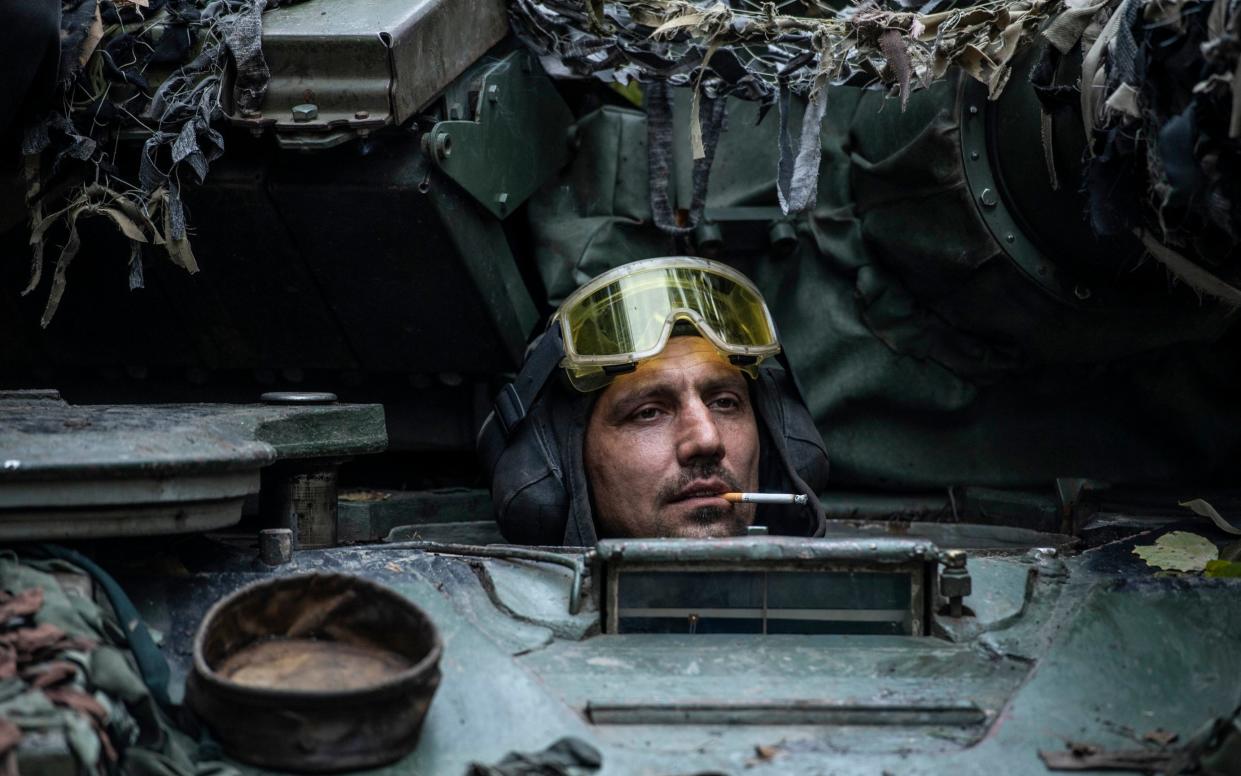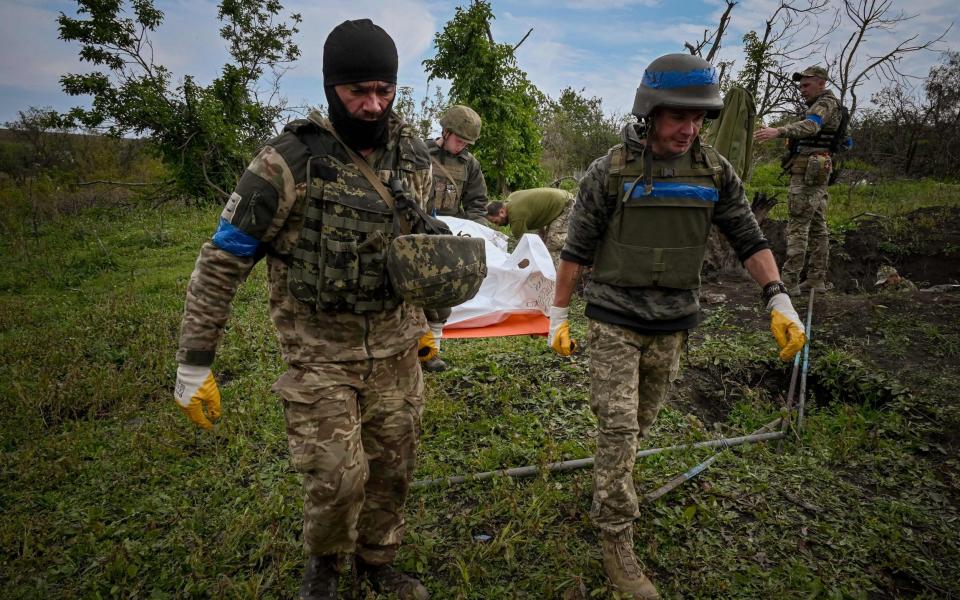Putin massing fresh forces on Kharkiv border ahead of possible renewed offensive

Russia is concentrating men and equipment near its border opposite Kharkiv for a possible renewed attack on Ukraine’s second city, the general responsible for its defence has warned.
Brigadier General Sergei Melnik, the commander of the Kharkiv military garrison, told the Telegraph that Russia was regularly firing tank shells and sending Iranian kamikaze drones across the border since withdrawing from positions north of the city last month.
“The situation is not calm,” he told the Telegraph in recently liberated territory north of the city on Monday.
“Furthermore on that side of the border they are building up a very large number of troops and equipment and so on. So what they are going to do next we don’t yet know.
“We can guess - either they will move in the direction of Kharkiv in the second echelon or towards Donetsk, but I don’t know yet. When they start to move and line up in battle formation, we will understand where they are going.”
It could mean Russia’s mobilisation is trying to replenish its armies more quickly than many Western analysts suggested.
Vladimir Putin announced “partial” mobilisation in Russia a week ago.
Many Western analysts suggested it would take two to three months for conscripts to reach the battlefield because they needed to be trained, equipped, and integrated into their units.
But reports from Russia suggest many conscripts have been dispatched to frontline units with as little as one day’s training.
Brig Gen Melnik said the Russian brigades that retreated across the border earlier in September had taken heavy losses but expected the Russians to try to disperse reservists amongst existing units to minimise the risk of mutiny.
“If you think the mobilised reservists are being gathered in one brigade, you are greatly mistaken,” he said. “The[Russian] 200th brigade that was standing there has 40 or 50 per cent losses. So they will replenish this 50 per cent. Then they will dilute the mobilised men among the other combat units, so they will not be able to escape.
“If they try to run away, I guarantee you there will be a shot in the head of the first, second and third. It will be a show of massacre for those mobilised men who want to flee.”
But he added: “The threat remains. You know how ambitious Putin is. You think he will forget the bitterness of what he lost, the defeat in Kharkiv region? I think not. So to expect some kind of meanness from him is obvious.”
Brig Gen Melnik has led the defence of Kharkiv since Russian forces crossed the border and tried to surround and storm the city in February.

The Ukrainians pushed them away from the city limits with a limited counter-offensive in May, but they held on to a large swathe of territory along the border and within rocket range.
The resulting battle in the hinterland around the city over the summer was bitter. Andrei Tonko, the 53-year-old commander of a Ukrainian tank still dug into the forest here, described terrifying artillery barrages and rapid counter-fire that made the slightest laziness deadly.
“If you stay still, you’re dead,” he said. “The first time we came under fire they just covered us with mortars. They had a drone up that spotted us. We were lying under the tank and then we realised if we stayed we were finished.”
Shortly afterwards the forest around them was subjected to an incendiary attack that he said was “phosphorus bombs.” The undergrowth in the area is still charred.
“I’m not saying the infantry have it easy - they have their own problems,” he said. “But if you’re in a tank, you are the first target the enemy looks for. The moment they spot you, you’re under fire - mortars, artillery, rockets. Then there are the landmines.”
The crew - the best in their brigade, according to the general, although they brush that off - are typical of the volunteer army now fighting this war, and the ageing equipment is overwhelmingly in use despite Western arms deliveries.
Tonko first served in tanks during his national service in the Soviet Army in the 1980s. His driver mechanic is a 44-year-old IT systems manager called Konstantin Kolomeyes. The gunner, 39-year-old Sergei Lupchik, ran a toy shop. They, too, did national service many years ago. None of them had been in combat before this summer.
Their tank is an elderly T64, originally captured from the Russians. Tonko says tankers prefer the vehicle they are used to, and that his crew are used to the 64 - but adds it is basically inferior even to the T-72 in everything from optics to engine. Its explosive-reactive armour "was good in the 70s. There's modern stuff now," said the commander.
Ukraine has frequently requested Nato-standard tanks from the West. Germany, which produces the Leopard, the one best suited to Ukraine's needs, has flatly refused. The Americans have hinted that tanks may be "on the table" but have not provided any.
In the last offensive two weeks ago, the crew faced light resistance. “We didn’t engage any enemy tanks. Only some fixed positions,” they said. “The artillery preparation worked.”

The Russians were finally evicted from the northern part of the region two weeks ago in an offensive timed to coincide with the major breakthrough to Kupiansk and Izyum further south.
The attack here was largely overshadowed by the larger assault but was no less carefully prepared.
Gen Melnick, who commanded the northern offensive, described it as a “demonstrative” supporting attack that led to a rapid Russian collapse.
“Before the offensive began we systematically knocked out their logistics. Artillery and Himars were working. We gave them targeting instructions and knocked out their warehouses, hammered them, fuel tankers, logistics, ammunition. Then they could not operate.”
“Maybe they received an order to retreat. I don’t know what happened. But as local residents told us, in the evening they were still around and in the morning they had vanished. They left behind their equipment, everything.”
The border is now secure, with Russian and Ukrainian forces facing one another from either side. But tank fire occurs daily, sometimes escalating into cross-border duels, Gen Melnick admitted.
“We answer. Previously we didn’t, but we got fed up,” he said. “We don’t fire on Belgorod or settlements. Only military positions. You could say we make sure they have accidental fires.”
A shell killed two civilian doctors in a civilian vehicle near Strilchy, a border village where Russian tanks are particularly active, earlier this week.
Volodymyr Zelensky said on Sunday that Ukraine had received the National Advanced Surface-to-Air Missile System (NASAMS), an advanced US system that Kyiv had been requesting for months.
Brig Gen Melnick denied that such systems have made it to Kharkiv yet.
“We need some kind of modern systems of the American type, British, which works at short range. The president just said these systems have arrived, but I don't know anything else about them.”

 Yahoo News
Yahoo News 
